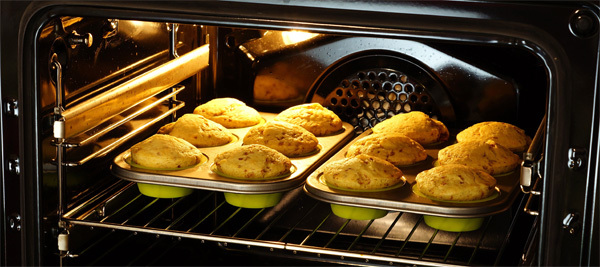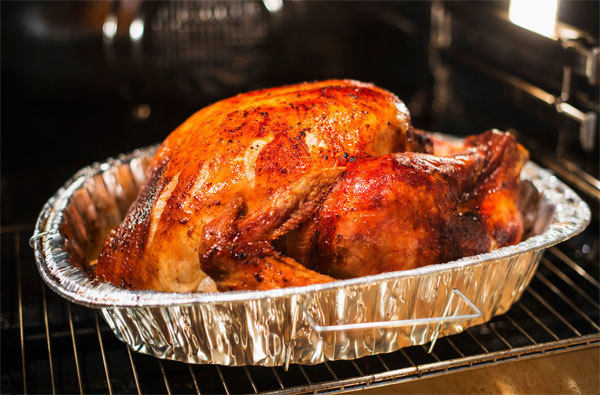How Do You Know If The Oven Is Baking?
by Joshua Speaks
Ovens can be super helpful to bake stuff, but they can also be super complicated. For example, how do you know if the oven is baking? What type of food can you cook in an oven? What types of ovens are there? And what’s even more important – how can you tell the food’s done?
We’ll answer all those questions here.
If you’re eager to find out how an oven bakes and how you can get the most out of it accordingly, then you’ll love reading this article. So don’t hesitate and scroll down!
Need an oven for baking? Read our top 10 reviews.
Contents
How Do Ovens Work?

First and foremost, let’s explain how ovens bake.
Almost all ovens have the same type of operation: they turn on a heating element or flame and heat up until they reach the maximum temperature. Then the heating element turns off and lets the temperature fall. Once the temperature is low enough, it turns on again to keep it close to what you set.
A gas oven has a similar process. But instead of turning off, it just lowers down the flame to let temperature accommodate if necessary.
Let’s say you set it a 300ºF – the oven will heat up until 500ºF and then come down to 280ºF, where it will turn the elements back on again to keep the temperature close to the initial 300ºF you set.
Makes more sense now, right? Well, there’s still a lot more to consider.
Types of Ovens
Now let’s explain how different ovens work. Here, you will find gas, electric, and convection ovens.
Gas
Let’s start with gas ovens. These are the most common, as people love gas stoves as well, and they come with a gas oven below. Like you should know, they work with a flame from a tube burner.
However, the flame can’t keep the entire oven heated, so they usually heat up more than necessary. Then they turn down the heat and try to maintain it, so the baking proceeds. This eventually reduces the accuracy of the temperature, as they take a few minutes to heat up entirely again.
Electric
An electric model uses one large heating element or two at the bottom. The heating element will heat up fast but exceed the desired temperature. Then it will reduce the heating element temp and try to maintain the temperature at the desired range.
This is effective and quick, but it takes a lot of electricity to work. Sure enough, it produces lots of fluctuation in temperature when it goes up and down consistently.
Convection
Then you get convection ovens. These reduce the overall inefficiency by combining the speed and power of heating elements with hot-air fans that keep the interior equally hot. That’s why they’re often the most efficient and easy to use – yet ultra-expensive at first.
But how do I know if my oven is convection? Easy, you simply look for the heating elements – probably 3 or more, and a fan in the back or the sides. That will let you know if it is a convection oven.
Still, convection ovens may also have fluctuating temperatures. So it is vital to check as well.
Testing if the Oven is Baking
After learning about the different oven types, you’re ready to learn how to spot whether the oven is baking or not. Here, we’ll teach you the various methods and/or processes that may work alone, or you can put together to find out. Take a look!
1. Use a Thermometer
The first thing you can do, and the most effective, is to always take the temperature of the oven interior when baking and see if it has a calibration issue.
If the oven is working at a lower temperature than the one you set, then it means you have an oven problem.
To check that, you’ll need an oven thermometer. It is the most useful tool you can use for this and an essential part of making sure the oven is baking.
Here’s how to use a thermometer:
- Place the thermometer on the rack where you usually place the food. Then make sure you can read it from outside.
- Now set the temperature to 350ºF or similar. Then let it preheat. Check that the temperature rises slowly, don’t get your eyes off it.
- Let it preheat thoroughly. How do you know when an oven is preheated? The thermometer should tell you when it reaches 350ºF. If it never does, then you probably have an oven issue. Otherwise, it should arrive there in about 5 minutes in an electric or convection, and 15 minutes in gas models.
- Now you can let the oven heat up for 1 hour. But you’ll have to come back and see every 10 to 20 minutes to see how much the temperature fluctuates. Note the temperatures down on a paper.
- Finish by adding every temperature reading together then divide it by the number of readings you took. For example, you took 5 readings at 300ºF - that would be 1,500ºF / 5, which means 300ºF in temperature.
- If you set it at 350ºF, this 300ºF media means the oven is not working correctly. But if the temperature got closer to 350ºF, then your oven has no calibration problem, and it should bake well enough.
2. Look for Hot Spots
If you checked for a calibration issue but didn’t find a fluctuation problem, then you may have a problem with the distribution of the heat.
This often happens with electric and gas ovens more than it happens with convection ones. But it’s still possible with all of them.
You can try two methods to check for hot spots: making toasts and cooking a whole turkey.
Making Toasts

Toasting bread on the oven in different pieces will tell you which areas are heating up more.
Here’s how to check this:
- Try making toasts in the oven. Place an entire loaf of sandwich bread in pieces. Spread them out in the grill, covering the whole surface. Let them cook for 30 minutes.
- After the 30 minutes, you’ll see which toasts cooked more, which burned, and which didn’t cook at all. If you spot uneven cooking, then you have a hot-spot issue.
- You’ll know which places are cooking more than others, so you’ll have to fix it accordingly. This could be either for an inefficient heat element, a broken burner, or a dirty oven heating system.
Cooking a Turkey

If trying with toasts didn’t spot the problem, then you can also try with a turkey. Cooking a turkey in the oven will tell you whether the oven is cooking more on one side than the other.
Here’s how to proceed:
- Place a large turkey (at least 10 pounds) in the oven and then set the oven to 375ºF. Let the turkey cook for at least 1 hour.
- While the turkey cooks, make sure to check each side of the turkey with the thermometer and see how the temperature fluctuates. If there’s a difference of more than 50º, then the oven probably has a heating issue.
- If the temperature is the same, then you can wait for the whole turkey to bake up thoroughly. Then check whether it has the same browning on both sides. If it does, then it shouldn’t have any problem. Otherwise, you probably have a hot-spot issue.
3. Check the Temperature Sensor
Whether you’re baking a turkey or cooking a lasagna, you’ll want to make sure that the temperature stays even throughout the cooking process. But as you know, this is sometimes not possible – especially when the temperature sensor stops working as it should.
When this happens, the temperatures fluctuate either too low or too high. As the sensor tells the oven how to graduate the temp, when it doesn’t work, it can mess up an entire meal.
Here’s how to check the temperature sensor:
- The sensor looks like a small stainless steel syringe. It should be touching the wall of the oven. Not on the top or the bottom.
- At the same time, it should be pointing towards the middle of the oven. If the sensor is pointing outwards, then that’s probably the issue.
- Grab the sensor and reinstall it to see if the oven keeps working regularly. Otherwise, you may need to fix it or replace it, so it starts baking normally.
4. Check the Element / Burner
Finally, you’ll have to check whether the heating element or the burner in the oven is working correctly.
As you know, the heating element is what heats up an electric and convection oven. And the burner is what heats up a gas oven.
So, how to tell if an oven element is broken? Or whether the burner is working as it should?
This is easy – here’s what to do:
- Start by starting the oven. Spark the flame on the gas oven or turn on the electric/convection oven.
- The gas oven burner should look even and consistent. In case the flame jumps or looks uneven, then you may need to clean it or replace it.
- If the element on the electric/convection doesn’t work, it won’t look orange after 10 minutes. But if it heats up but a section doesn’t glow red/orange, then it means it needs replacement.
- In case you don’t spot any problem with either the burner on a gas stove or the heating element in a convection/electric oven, then you should have no issue baking.
Wrapping Up!
So, how to ensure if the oven is baking or not? Follow our four methods:
- First, check with a thermometer that it gets to the desired temperature and doesn’t fluctuate much down. If it doesn’t fluctuate, then it should bake well.
- Otherwise, look for hot spots by baking/cooking something. When it isn’t, some sections of the oven will cook up more than others.
- Then check that the temperature sensor is not broken or wrongly installed. If it is, then reinstall it or replace it as necessary.
- Lastly, check for the heating element or burner to see if it works. If it is working unevenly or not heating up correctly, then it’s time to replace it, fix it, or simply clean it.
So, is your oven baking? Check with these tips, and you should find out.

About Joshua Speaks
Can’t think of a day that that Josh didn’t have a beer or two. Be it a long day of work or of nothing. Sometimes, it is a few packs even. Especially when there are familiars over.
His fridge is packed with beers: Heineken, Corona, Guinness, Budweiser, and all other wierd brands in between. He had to get a secondary 30 cu. fridge off Craigslist for more beer storage.
Sometimes he wonders if a day truly starts only after the first sip of beer for the day. Enough talk about Josh and his passion; that’s the reason for this beer blog and related items. Feel free to hit on him. Start with something like: “hey beer head!” You got the idea!
Thoughts on "How Do You Know If The Oven Is Baking?"
 |
 |
 |
 |
Kitchen - Outdoor